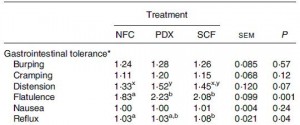I heard a comedian say he wished exercise was like high school; once you get your diploma, that’s it. You never need to do high school again. Unfortunately, the same isn’t true with artificial nutrition. the mad food scientists are at it again.
Enter: Soluble corn fiber (SCF), mass produced by Megatron Promitor
 Over a decade ago, Atkins released low carb bars. Well, they weren’t actually low carb per se, they were low sugar. This was accomplished by replacing sugar with glycerol (a sugar alcohol) and polydextrose (a pseudo-fiber). While their bars are made from cheap ingredients and low quality protein, sugar alcohols and pseudo-fibers are certainly better than sugar.
Over a decade ago, Atkins released low carb bars. Well, they weren’t actually low carb per se, they were low sugar. This was accomplished by replacing sugar with glycerol (a sugar alcohol) and polydextrose (a pseudo-fiber). While their bars are made from cheap ingredients and low quality protein, sugar alcohols and pseudo-fibers are certainly better than sugar.
Later, sugar alcohols took off in popularity, appearing in Met-Rx Protein Plus, Detour Lean Muscle
, Dymatize Elite Gourmet
, etc., etc. Glycerol was prominent in Labrada
and Pure Protein
bars. Supreme Protein
bars use glycerol and maltitol, and a LOT of ‘em. Quest
took a stand against glycerol and uses the lower calorie and more stomach-friendly erythritol (if it ends in “-ol,” its probably an alcohol).
More recently, the field took a considerable philosophical leap forward and starting using real fiber, good fiber. Inulin appeared in some Atkins bars, VPX Zero Impact
, and the original Quest bars. Quest has since switched to another good fiber, isomalto-oligosaccharides. Unfortunately no one is using GOS, yet, but they will … mark my words (that’s a prediction, or stock tip… not a threat).
But now the field has taken a turn and we have another artificial ingredient, a pseudo-fiber, with which to deal. “Soluble corn fiber (SCF)” first appeared in Splenda Fiber packets and then in Promax LS
bars.

If you’re like me, you’re asking yourself: what is this stuff? Is it real fiber? Is it like the super fibers inulin and GOS
? Hello Pubmed
Divide and conquer
Stewart (2010) compared SCF to 3 other fibers and maltodextrin, 12 g/d x 2 weeks =

Pullulan, a rather potent fiber, is not well-tolerated. Resistant starch (an insoluble fiber), soluble fiber dextrin, and SCF were all OK. The gut microbiota seemed to have no preference, as short chain fatty acid production was similar in all groups (perhaps 12 grams is subthreshold?). Similarly, health biomarkers, hunger levels, and body weight were unaffected.
Boler (2010) compared a commercially available SCF preparation to polydextrose, 21 grams per day for 21 days in 21 healthy men (cute.)
NFC, no fiber control; PDX, polydextrose; SCF, soluble corn fiber
In this study, however, SCF didn’t do so well. It caused gas and reflux. Perhaps this wasn’t observed in Stewart’s study because of the lower dose (12 vs. 21 grams). Furthermore, polydextrose reduced while SCF increased short chain fatty acid production, both of which resulting in a higher acetate:butyrate ratio. So unlike 12 grams of any of Stewart’s fibers (including SCF), the gut microbiota seems to respond to 21 grams of SCF. And they pooped more (both fiber groups).
Data are expressed as log cfu/g feces.
Interestingly, SCF was remarkably bifidogenic. Much more so than PDX, MOS (see Yen et al., 2011), and inulin (see Menne et al., 2000), but WAY less than GOS (see Silk et al. 2009).
This same group reported a more detailed analysis of the gut microbiota which unfortunately did NOT exactly confirm their earlier finding (Hooda et al., 2012):
Data presentation is different in the two publications, and if both are true, then SCF selectively increases a few specific strains of bifidobacteria but reduces many others (enough to increase the total amount but decrease the variety). The functional implications of this are unclear (to me).
In the meantime, SCF appears to be at most an OK pseudo-fiber substitute. Megatron Promitor is not likely to test it against the super fibers (e.g., inulin, GOS, etc.) any time soon, so we won’t know if it’s an advance or simply a side-step. Such is life.




